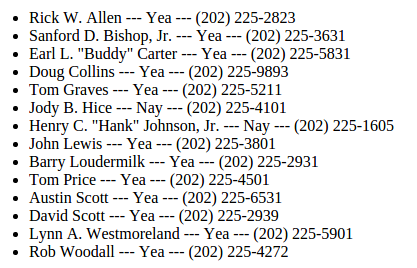One of the things that yesterday’s output lacked was the full names of the Georgia representatives. Which aren’t reported in the roll call documents.
But, what the roll call documents do have, is the following:
<recorded-vote>
<legislator name-id=”J000288″ sort-field=”Johnson (GA)” unaccented-name=”Johnson (GA)”
party=”D” state=”GA” role=”legislator”>Johnson (GA)</legislator>
<vote>Nay</vote>
</recorded-vote>
With emphasis on name-id=”J000288″
I call that attribute out because there is a sample data file, just for the House of Representatives that has:
<bioguideID>J000288</bioguideID>
And yes, the “name-id” attribute and the <bioguideID> share the same value for Henry C. “Hank” Johnson, Jr. of Georgia.
As far as I can find, that relationship between the “name-id” value in roll call result files and the House Member Data File is undocumented. You have to be paying attention to the data values in the various XML files at Congress.gov.
The result of the XQuery script today has the usual header but for members of the Georgia delegation, the following:
That is the result of joining/merging two XML files hosted at congress.gov in real time. You can substitute any roll call vote and your state as appropriate and generate a similar webpage for that roll call vote.
The roll call vote file I used for this example is: http://clerk.house.gov/evs/2015/roll705.xml and the House Member Data File was: http://xml.house.gov/MemberData/MemberData.xml. The MemberData.xml file dates from April of 2015 so it may not have the latest data on any given member. Documentation for House Member Data in XML (pdf).
The main XQuery function for merging the two XML files:
{for $voter in doc(“http://clerk.house.gov/evs/2015/roll705.xml”)//recorded-vote,
$mem in doc(“http://xml.house.gov/MemberData/MemberData.xml”)//member/member-info
where $voter/legislator[@state = ‘GA’] and $voter/legislator/@name-id = $mem//bioguideID
return <li> {string($mem//official-name)} — {string($voter/vote)} — {string($mem//phone)}&;lt;/li>
At a minimum, you can auto-generate a listing for representatives from your state, their vote on any roll-call vote and give readers their phone number to register their opinion.
This is a crude example of what you can do with XML, XQuery and online data from Congress.gov.
BTW, if you work in “sharing” environment at a media outlet or library, you can also join/merge data that you hold internally, say the private phone number of a congressional aide, for example.
We are not nearly done with the congressional roll call vote but you can begin to see the potential that XQuery offers for very little effort. Not to mention that XQuery scripts can be rapidly adapted to your library or news room.
Try out today’s XQuery roll705-join-merge.xq.txt for yourself. (Apologies for the “.txt” extension but my ISP host has ideas about “safe” files to upload.)
I realize this first week has been kinda haphazard in its presentation. Suggestions welcome on improvements as this series goes forward.
The government and others are cranking out barely useful XML by the boatload. XQuery is your ticket to creating personalized presentations dynamically from that XML and other data.
Enjoy!
PS: For display of XML and XQuery, should I be using a different Word template? Suggestions?
